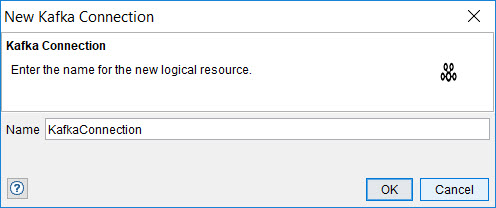Creating logical Apache Kafka transport connections
In HCL OneTest™ API, tests and stubs reference the logical resources in a project. Therefore, you must create at least one logical Kafka transport connection for each Kafka transport to be used.
Before you begin
You must have at least one environment in your project. If there are no environments, you must create one. See Creating an environment.
Procedure
- Open the Logical View of the Architecture School perspective.
-
On the toolbar of the Logical View, click .
The New Kafka Connection window is displayed.
-
Enter a name for the connection in the Name field.

-
Click OK.
The New Kafka Connection window is closed and the new logical Kafka connection is displayed in the canvas of the Logical View.
- When a logical connection is created, a new physical resource is also created and bound to the logical connection. To view or edit this physical resource, right-click the new connection and click Physical Resource.
-
Double-click the new logical Kafka connection.
The Kafka Connection window is displayed.
Alternatively, right-click the logical Kafka connection and then click Open.
-
To associate the new logical Kafka connection with a different
logical resource, complete the following tasks:
-
Optionally, click the Bindings tab. Alternatively, click in the menu bar to open the Environment Editor window
and click the Bindings tab to modify the bindings of the selected
environment.
If you did not bind the Kafka connection to a physical Kafka broker, UNBOUND is displayed under Binding and you must complete the following tasks:
-
Optionally, to add a log file for the new logical Kafka connection, click the
Monitoring tab.
You can monitor the log file during the execution of a test that involves the new logical Kafka connection.
- Optionally, to enter additional information about the new logical Kafka connection, click the Documentation tab. Although this additional information is optional, it might help with the maintenance of the resources in the project or help future users of the project.
-
Optionally, to specify the name of the topics or pattern of topics that should be
recorded when using a Kafka
broker as a source, click the Recording tab.
Restriction: The specified pattern for topics to be recorded is not supported when the recording is enabled through the configured proxy.
- Click OK.
Results
The new logical Kafka connection is added to the project.